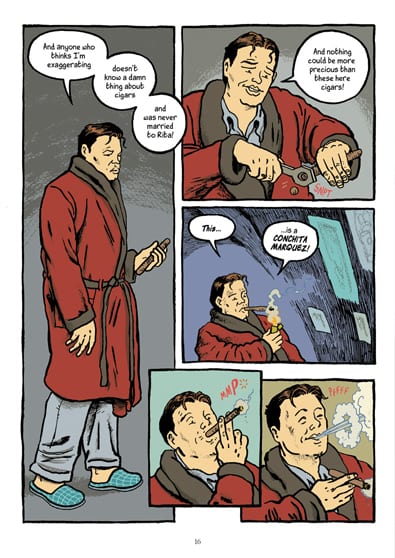The Cigar That Fell In Love With A Pipe is a hard book to pin down. At heart, it's an unconventional fairy tale romance, and as such, it owes everything to artist Nick Abadzis, who brings that fairy tale to life. Written by David Camus, this is a book whose imagery is visceral and funky: the smell of smoke, the feel of sweat from Cuban heat, the taste of salt from the ocean, the sound of Orson Welles' mellifluous voice, and of course the ways in which light and smoke play against each other. The book has a nested narrative structure, as what appears to be the beginning of the story of Welles receiving a box of cigars is actually almost the end of magical story of two spirits in love.
The reader is first introduced to the famous actor and director Orson Welles at home in 1947, smoking a very special box of cigars. From the story's onset, the reader is clued into Welles' passionate nature: the way he expresses his love for smoking and movies gets at the heart of a sort of cultivated and cultured hedonism. On the other hand, his relationship with then-wife Rita Hayworth seems to run along the lines of mutual aggravation. It's a marriage of proximity, a marriage of expectations based on the notion that the famous director should be married to the most beautiful actress in Hollywood. To Camus' credit, Hayworth is portrayed as being equally dissatisfied, unhappy with being regarded as a beautiful woman on Welles' arm instead of an equal collaborator and intellect.
This ironically downbeat real Hollywood relationship is juxtaposed against the fantasy story of Conchita Marquez. A powerful, dexterous, and large woman, she is the premier cigar-maker in Cuba at a time when Cuban cigars were the most coveted on the planet. Once again, Abadzis picks up the narrative and makes Conchita and her surroundings larger than life. While giving Conchita a certain power and presence as a figure, Abadzis gives the wealthy cigar-smoking men a cartoonish and even slightly buffoonish mien. Conchita eventually marries the owner of the cigar factory at which she works, but it is a marriage of convenience, not love. The owner wants to have her continue to make him rich instead of having her defect to another factory, but she doesn't care: her only interest in life ss her craft. In a slightly ham-fisted move, Camus has Welles remark that she is "just like Rita" in that regard, when the parallel between the two women and their situations is made quite clear through the narrative.
About a quarter of the way through the book, it starts to veer toward fantasy. A gorgeous six-page spread of Conchita dreaming that she's floating above everything sees Abadzis excel as a colorist, choosing deep purples, vibrant greens, and light violets to illustrate her trip through the sky and the night, always encircled by a mix of clouds and sweet smoke. From there, Camus throws in the ultimate monkey wrench, as Conchita learns that she's allergic to tobacco and that rolling it could kill her, and she's sent to Switzerland to heal. Of course, she can't quite resist taking some tobacco with her, which winds up being her doom. She falls in unrequited love with a cigar-smoking sailor on the journey to Europe, and the rest of the book goes deeper and deeper into fantasy via the eventual union of the souls of Conchita and the sailor. Conchita finds her soul bound to one of her last cigars, while the sailor's is bound to an exquisite hand-carved pipe that he made prior to being struck by lightning. While it's all a bit absurd, Abadzis once again finds the right touch behind lighthearted design and lushly-colored fantasy in these pages.

As the story of Conchita and her love loops into Welles' story of his dysfunctional relationship, the reader is given what appears to be a happy ending. A mischievous boy is introduced to seemingly throw a spanner in the works, but Hayworth stops that plot device in its cliched tracks. Of course, her proving to be the undoing of both the fantastic miracle of uniting two souls is also the undoing of her own marriage, a neat twist that ties up every knot. Or so it seems, until the last sixteen pages of the book. They are dedicated to the wispy, smoke puff remnant of Conchita's soul making its way toward the light. What could have been a hokey sequence is actually quite beautiful, thanks to Camus' restraint (it's entirely wordless) and Abadzis' mastery of color. Their collaboration in general is one of mostly understatement on Camus' part and all-out (but tasteful) visual assault on the part of Abadzis, as it is up to him to really make the reader feel everything described in the book. Abadzis combines aspects of children's book-illustration and rock-solid cartooning to make both the fantastic and mundane narratives in the book effective.









